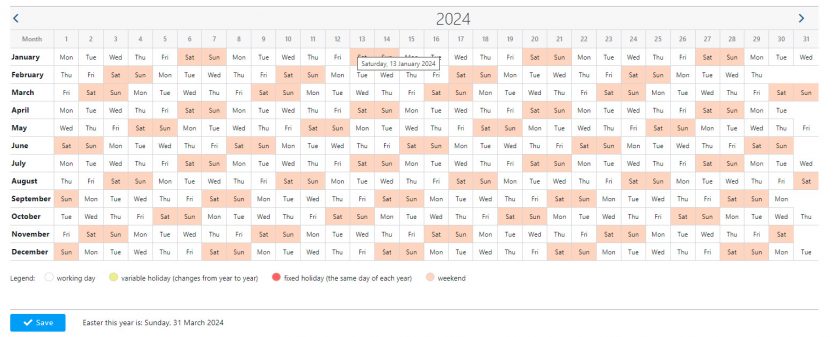Corporate calendars are convenient tools for keeping track of meetings, deadlines, and milestones.
They can help you visualize the schedules of various projects and remind you of important team events, such as colleagues’ leave periods.
The problem is that far too often, multiple calendars are managed simultaneously and are not even integrated with each other.
This lack of synchronization can confuse and lead to missed deadlines.
Since time management shapes the results of a project, using multiple corporate calendars plays a key role.
CONTENT
Christopher Vardanyan, co-founder at Rocket Moving Services, highlights: “Managing multiple corporate calendars helps improve communication and flexibility within our team. At Rocket Moving, we handle various orders each day, and each move requires its own set of resources and attention. When our calendars are synced, it’s easier for our team to coordinate—whether it’s scheduling a client’s move, monitoring employee availability, or adjusting plans in real-time when unforeseen challenges arise. This integration has also improved our order-handling process by about 20%, as we can quickly assess availability and respond to client inquiries faster. This helps us stay adaptable and responsive, ensuring smooth operations even during peak seasons.”
As seen, using multiple calendars becomes a powerful resource for organizing activities, coordinating the team, and ensuring timely project delivery.
Let’s learn more about this subject in this article.
Why is the calendar important in project management?
Conventional calendars are undoubtedly helpful in establishing a schedule and displaying time flow. Still, they are not optimal for teams that manage multiple projects simultaneously and need to make changes to the schedule.
There are many advantages to using multiple corporate calendars:
Clear activity overview
The first perk is displaying all tasks, events, and milestones in one place. Project managers can immediately see the task, the team member assigned, and the timelines associated with that specific job.
Also, team progress can be monitored, and bottlenecks can quickly be identified before they jeopardize the project.
Better communication
Multiple corporate calendars can be easily shared across departments, significantly improving internal communication and facilitating better work coordination.
Team members can easily collaborate on different planned tasks within a calendar, while project managers and supervisors can relay vital information. This is particularly important for remote workers.
Improved planning
Multiple business calendars help project managers accurately plan the schedule for one or more projects by organizing tasks sequentially.
Clear deadlines can thus also be set based on dependencies between activities.
Efficient resource allocation
Efficient resource utilization is still one of the most important goals for project managers in all industries.
By using multiple company calendars, project managers can optimally use available resources by assigning tasks to the right people based on their availability and workload.
Fair and even distribution promotes employee engagement and increases job satisfaction, increasing productivity and bonding with the company in the long run.
Why use project management software to create a project calendar
Many people may think that using Excel or Google Calendar is good enough to create and manage project calendars.
These are surely great tools, but only up to a certain point.
Let’s see what their limitations are:
Excel calendar limitations
Excel is one of the preferred calculation tools for companies. Yet, compared with a project management calendar, Excel suffers from the following limitations:
- Lack of control and security: Excel is not user-friendly, and the app will slow down if the data is too big. Furthermore, it is a stand-alone tool that does not provide adequate control because there is always the risk of errors when manual changes are made.
- It is hard to keep track of project progress: Excel is not ideal for project management teams because it is impossible to track project progress easily.
- Not designed for collaborative work: Excel doesn’t offer key collaboration tools required by both in-office and remote teams today.
Google Calendar limitations
Although Google Calendar is a great tool for scheduling meetings and appointments, it presents the following limitations when it comes to project management.
- Limited project management features: Why would project teams use a limited tool like Google Calendar over a project management software offering a wide range of features? Google Calendar lacks many essential features that project teams need in their daily work.
- No activity management: Google Calendar does not provide the option to manage tasks, making it difficult for project managers to assign tasks and responsibilities, set deadlines, and monitor progress at any given stage.
- Limited customization: Google Calendar offers limited customization options, and its UI is too simplistic when it comes to more complex projects.
Twproject: the revolution in multiple corporate calendars
Twproject recently introduced the multiple corporate calendar feature. Previously, you could only define one corporate calendar, but now you can create and assign separate calendars for each project and resource.

This innovation is crucial for companies with different departments or branches in foreign countries, which have different work requirements and follow different holiday calendars.
Project managers can design calendars, including working days and holidays, adapting to the specific needs of resources. Different calendars can be assigned to each resource, as well as to projects or individual phases.

The new feature improves task planning flexibility and accuracy. Users can set calendars via Gantt chart and view the effects of changes immediately.
Thanks to Twproject’s multiple corporate calendars, you can optimize time management and increase flexibility in resource planning.
Twproject calendars will put order into chaos by promoting coordination, smart planning, and workflow efficiency.
Give this and other features a try for free for 15 days.




